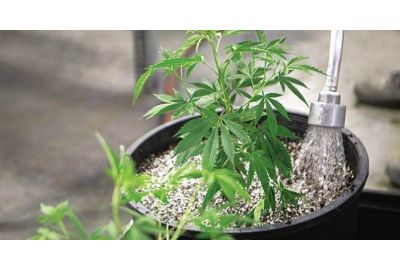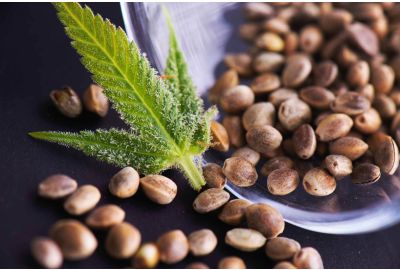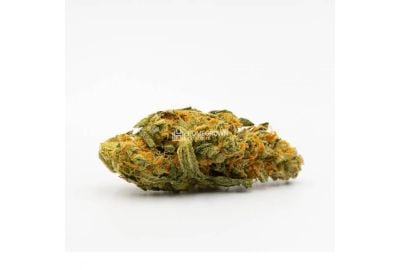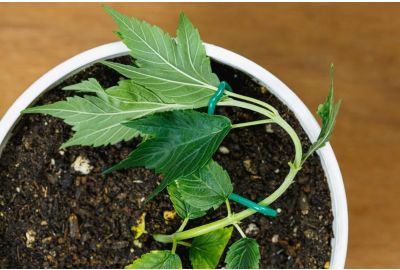LST Autoflower: Step by Step Guide
Are you a fan of autoflower cannabis but wish they were a little more productive? If so, stick around to learn some LST autoflower techniques to help boost your bounty of buds to enormous levels.
Read on to learn about low-stress training in autoflowers and how to use this easy technique to multiply your harvests.
LST autoflower: What is it?
The initials in LST autoflower stand for low-stress training. Training is a way of changing how your cannabis plants grow. All cannabis cultivars display a quality known as apical dominance regardless of individual strain characteristics.
Apical dominance causes cannabis plants to focus the bulk of their energy on one main central stem. This core branch develops a large cola, with surrounding branches producing less impressive buds.
This apical dominance gives cannabis plants their distinct pyramid or Christmas tree shape. While unmanaged plants may be visually appealing, they’re not the most efficient bud producers.
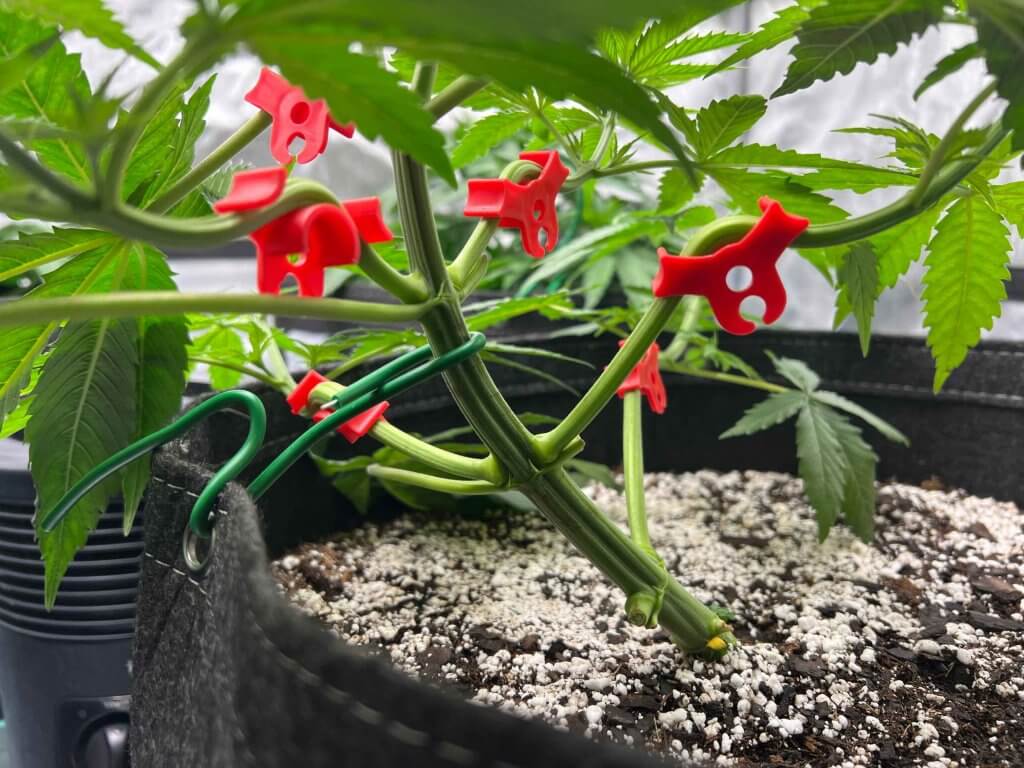
Growers attempt to curb this tendency in their cannabis through training. Successfully training your crops ultimately results in higher yields thanks to several factors.
Plants grown from regular or feminized cannabis seeds may be trained in two different ways. High-stress training (HST) methods like topping cannabis or supercropping entail removing parts of your plants to direct their growth. Plants undergoing HST experience slowed growth as they recover from the shock of damage.
Regular and feminized plants have a long vegetative period. This gives them the necessary time to recover without affecting yield.
The rapid life cycle of autoflower cannabis means HST is a poor fit if you’re trying to increase your yields. A short vegetative period with no means of extending it through lighting means autoflowers can’t recover from the shock of HST.
The likely results of using HST on autoflowers are severely stunted growth and correspondingly lower yields. Luckily, the second kind of training is perfect for autoflowers: low-stress training (LST).
Unlike HST, low-stress training for autoflowers won’t stress your plants or stunt their growth. Instead, LST for autoflowers makes gradual changes over time to your cannabis.
Low-stress training autoflowers is the perfect way to increase your yields. Keep reading to learn the many benefits of LST for autoflowers and how to do it yourself.
Low-stress training autoflowers: why should you consider it?
You should consider low-stress training your autoflowers for one main reason; vastly increased yields. With some care and attention, it’s possible to double or even triple the number of buds your autoflower cannabis produces.
Low-stress training autoflowers is also the only suitable training method to use with these rapidly-growing hybrids. Supercropping or topping autoflowers to increase yields usually ends in disappointment.
Finally, LST of autoflowers is easy to implement and a low-cost way of improving productivity. You don’t need to be an expert to get the benefits of low-stress training autoflowers, so why not give it a shot?

Low-stress training for autoflowers advantages and disadvantages
If you’re looking for a quick breakdown of the pros and cons of LST for autoflowers, check out this table. You’ll find each point addressed in more detail below.
| Advantages | Disadvantages |
| Efficient Use of Space | Increased Maintenance |
| Maximum Light Penetration | Loss of Main Cola |
| Improved Airflow | Visual Appeal |
| Less Stretching | |
| Enhanced Bud Density | |
| Increased Yield |
Advantages
The advantages of low-stress training autoflowers far exceed the largely superficial disadvantages. If you’re willing to put in some extra work, your marijuana gains the following benefits.
Efficient use of space
Low-stress training your autoflowers allows them to use the space they have more efficiently. Breaking apical dominance creates a lateral canopy of equally lit branches that all produce substantial amounts of flowers.
Maximum light penetration
Low-stress training for autoflowers spreads out a plant, allowing light to reach more parts. This increased exposure to light enhances growth in both the vegetative and flowering stages.
Improved airflow
Low-stress training your autoflowers maintains fresh airflow around your plants. This is crucial for a healthy crop of cannabis, as it prevents moisture buildup, which could lead to bud rot, mold, or mildew.
Less stretching
Unmanaged plants receiving inadequate light stretch to get the energy they need. This stretching wastes energy that could be used in flower production and may result in weak, gangly plants.
Low-stress training your autoflowers reduces stretching to a minimum by creating a flat growth canopy without dominant stems. This means all plant parts receive equal light, eliminating the need for stretching.
Enhanced bud density
The reduction in stretching achieved by low-stress training autoflowers leads to a flourishing plant with no branches competing for the light. This leads to a thriving crop of cannabis that directs all its energy into the production of dense, bulky buds.
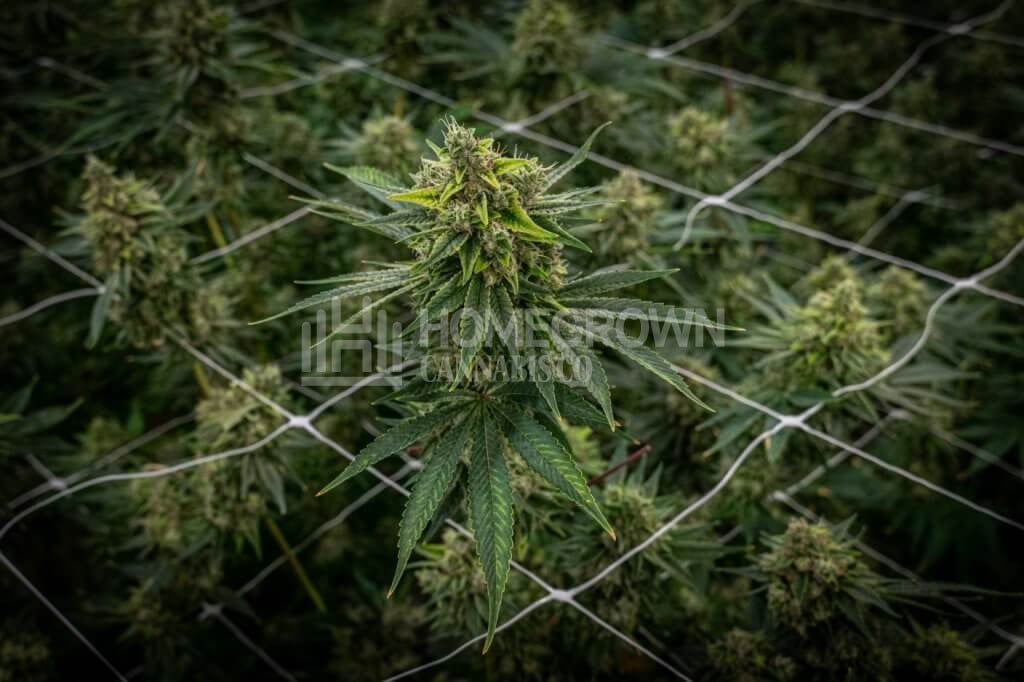
Increased yield
The culmination of all these benefits of low-stress training autoflowers is vastly increased productivity. LST autoflower plants produce more buds of higher quality than untrained specimens.
Disadvantages
There really aren’t any significant drawbacks of low-stress training autoflowers. Aside from some more work, the disadvantages are purely superficial and won’t impact the quality of your cannabis in any way.
Increased maintenance
The main downside to low-stress training autoflowers is the increased time it takes to maintain your crop.
While we think the results are more than worth the extra time invested, we know some people use autoflowers for their low-maintenance qualities.
While the thought of LST your autoflowers every day might seem like a chore, it’s not so bad. Once you’ve completed the initial training, maintaining it takes just a few minutes as long as you’re consistent.
Loss of main cola
Low-stress training your autoflowers means saying goodbye to that beautiful, enormous central cola we love to show off.
Instead of one giant main bud, how about twenty large ones? Low-stress training your autoflowers might not produce one singularly impressive cola, but it’s a small price to pay for improved yields.
Visual appeal
This one is less of an issue for autoflowers, as you’re not dealing with the most towering types of plants available.
Despite that, if it wasn’t already clear, low-stress training autoflowers produce plants that are very atypical in appearance.
Breaking the apical dominance of cannabis causes it to lose much of its signature shape and symmetry. If you want picture-perfect marijuana, it is best to leave yours unmanaged.
If you want copious amounts of extra-resinous, extra-dense buds on the other hand, LST and autoflowers are the perfect match.
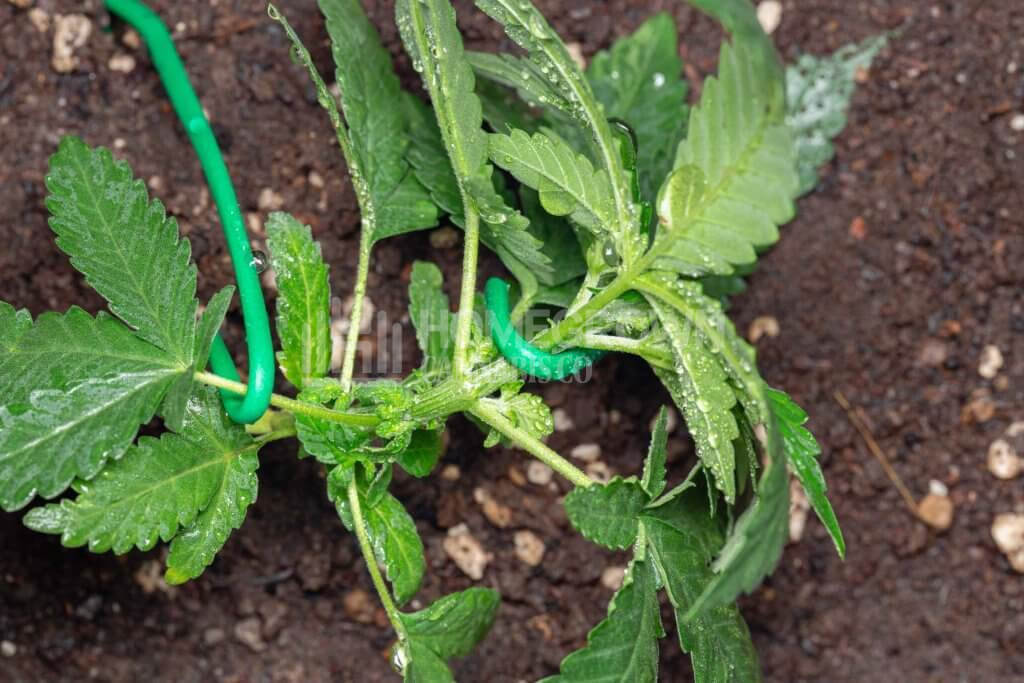
When to start LST on autoflowers
Start low-stress training your autoflowers as soon as they properly enter the vegetative stage. This is usually around 2–3 weeks after germination when the plants gain their first true leaves.
Unlike regular strains, autoflower marijuana doesn’t give you much time to play around with. To get the best results, start as soon as possible and continue low-stress training your autoflowers until they start to flower.
When to stop low-stress training autoflowers
Stop low-stress training your autoflowers as soon as the pre-flowering stage begins.
It’s important to stop at this point, as further stress, no matter how little, may negatively impact your yields. That’s why it’s important to remain consistent when low-stress training autoflowers; there isn’t time to “catch up” if you slack off.
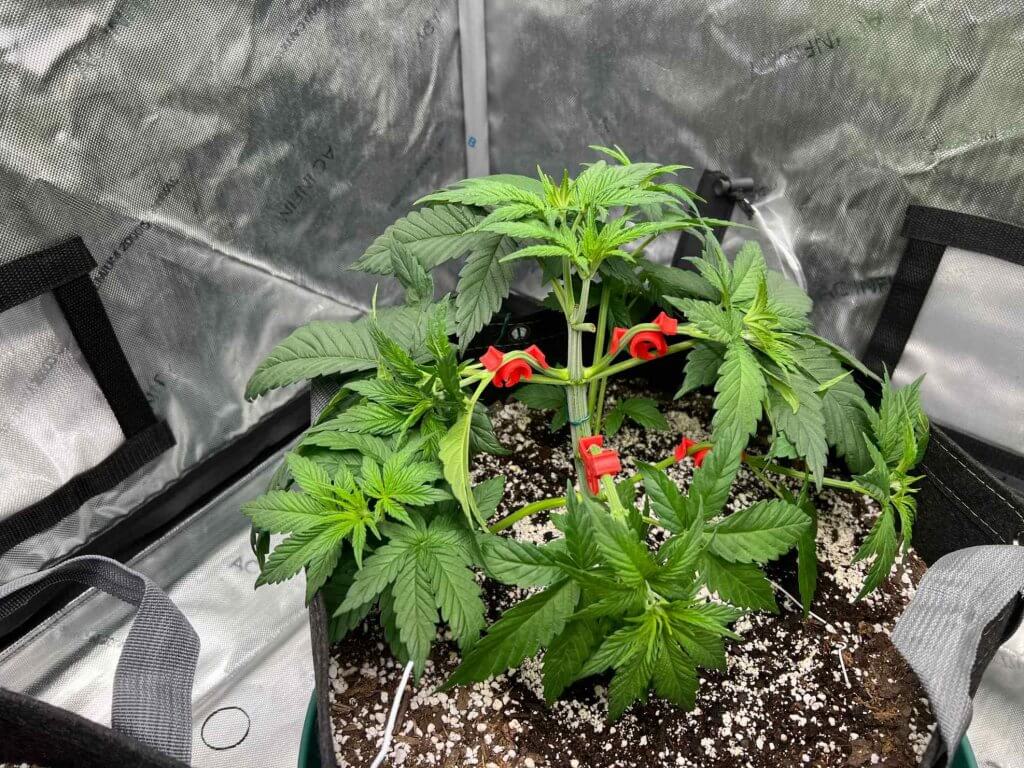
How to LST autoflowers: 3 methods for LST autoflower step by step
Now that you know why and when to start low-stress training autoflowers, all that’s left is how to LST your autoflowers.
Read on for three LST autoflower step-by-step guides. You’ll find a basic, intermediate, and advanced method for low-stress training your autoflowers. Even the most DIY-averse growers can increase their yields using our autoflower LST guides.
Tie-down method
The tie-down method is the first and easiest to implement of our LST autoflower techniques. This simple LST autoflower method requires just a few things to get up and running.
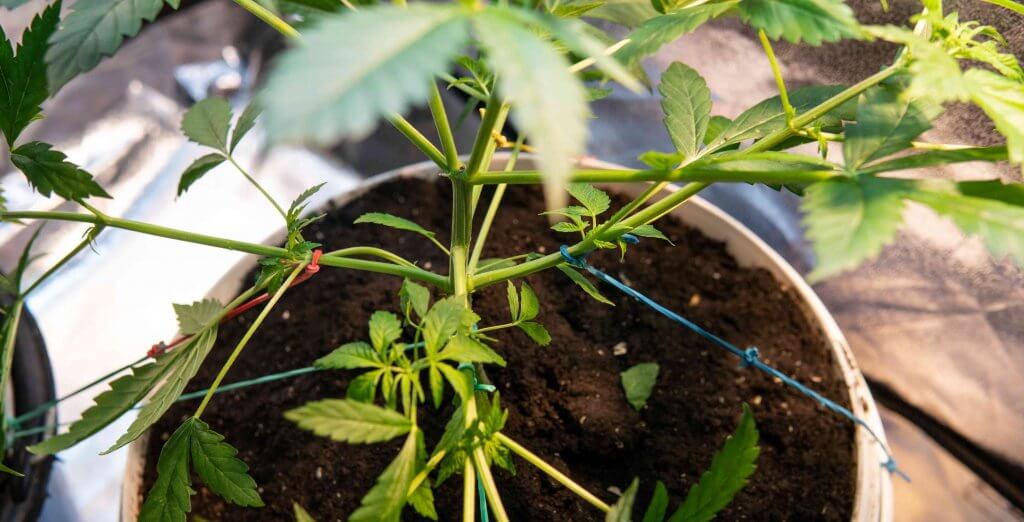
Step 1: Pre-preparation
Start by gathering everything you’re going to need to LST your autoflowers. You’ll only need a few bits and pieces to start this LST autoflower technique.
Get some tying materials to use on your plants. Garden centers carry plant wire and specially designed ties that won’t damage stems.
In the absence of these, something like pipe cleaners or shoelaces work as an acceptable substitute. The main point is to use tying material that won’t cut into or cause abrasions in your plants.
The most convenient form of this LST autoflower method involves tying the plants to their own pots. Doing it this way means rotating or moving the plants is easy, and you don’t need to dismantle and reassemble everything.
If you’re using fabric or air pots, and you should be, attaching the ties is simple. Use safety pins or clips for fabric pots, while air pots are studded with easily accessible holes.
If you’re using regular pots, you’ll need something to make holes around the rim. A power drill tackles this task in seconds, so grab one if possible. Alternatively, a piece of heated steel wire does the trick; just be careful.
It’s not a bad idea to have some bamboo or stakes handy when low-stress training your autoflowers. They help stabilize the plant against the pull of the ties.
Step 2: Preparation
Once you’ve got what you need, it’s time to prepare your pots. Make evenly spaced holes around the rims, or attach safety pins in the case of fabric pots. Air pot users, feel free to skip this step, as your pots come ready for low-stress training autoflowers.
Transplant your seedlings to the prepared pots and avoid filling them too full with soil. Leave an inch or so from the top to make the holes easy to access and work with.
Now is the time to stake your plant’s central stem for stability. A short stake is all that’s required; this helps the plant resist the pull of the ties.
Step 3: Tying down
The next step in low-stress training your autoflowers is tying down branches. The goal is to create a flat, even canopy of foliage with all parts receiving equal light.
While it’s not rocket science, it’s best to take some time to examine your plants before diving in blind. Spend some time assessing your crops from all angles and decide where you will make changes.
Once you’ve got a rough idea of what you’re going to do, it’s time to begin. Test the flexibility of the branches by slowly, gently bending them into place. Remember, LST for autoflowers is a gradual process, so don’t rush it and avoid any broken or snapped limbs.
Now that you know how far the branches bend, tie a string to a nearby hole, and attach it to the branch using a non-abrasive plant tie. Tighten the string enough to hold the branch in place firmly.
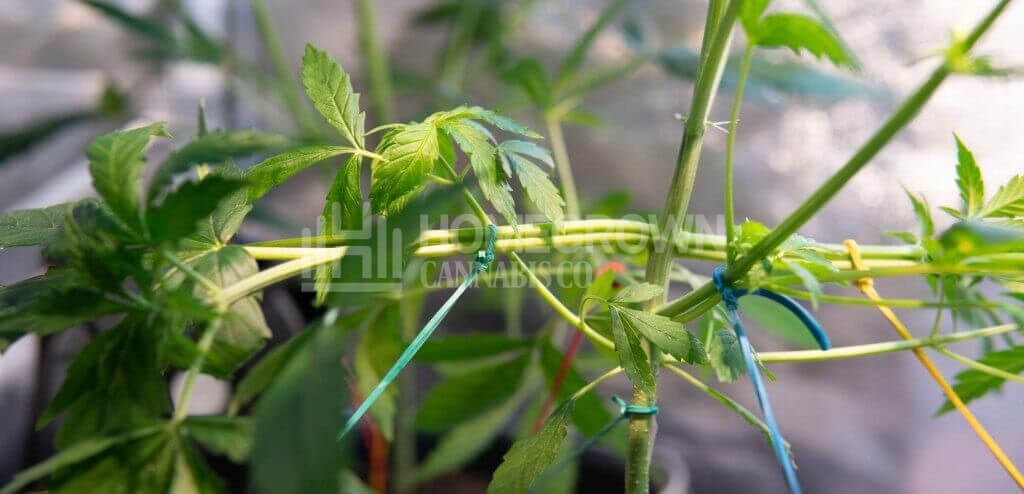
Step 4: Maintenance
Low-stress training autoflowers isn’t a one-and-done process. It requires daily upkeep and maintenance to produce the best results. Think of it as a process of constantly guiding your cannabis toward your desired shape.
Revisit the process of low-stress training your autoflowers daily. You’ll be surprised at how quickly your trained stems and branches turn back toward the light. Continue to LST your autoflowers consistently throughout the vegetative stage.
Once you see signs of pre-flowering, it’s time to relax. Making small adjustments is fine, but the main work should already be done by this stage.
Step 5: Flowering
Once flowering starts, the bulk of low-stress training your autoflowers is done. Now it’s time to focus on pruning and upkeep. Trim back and prune any leaves or smaller undeveloped branches to redirect energy into flower production.
This also helps ventilate the plants, reduce moisture buildup, and prevent mold or mildew from taking hold.
Sit tight and wait for harvest to arrive to see the real payoff of low-stress training autoflowers. Once you unlock the full potential of your cannabis with this simple LST autoflower technique, you’ll never go back.
Screen of Green
The Screen of Green or ScrOG setup is a slightly more advanced LST autoflower technique. It takes a little more setup but provides better results than low-stress training your autoflowers using the tie-down method.
Let’s jump straight into our autoflower LST guide to the Screen of Green.
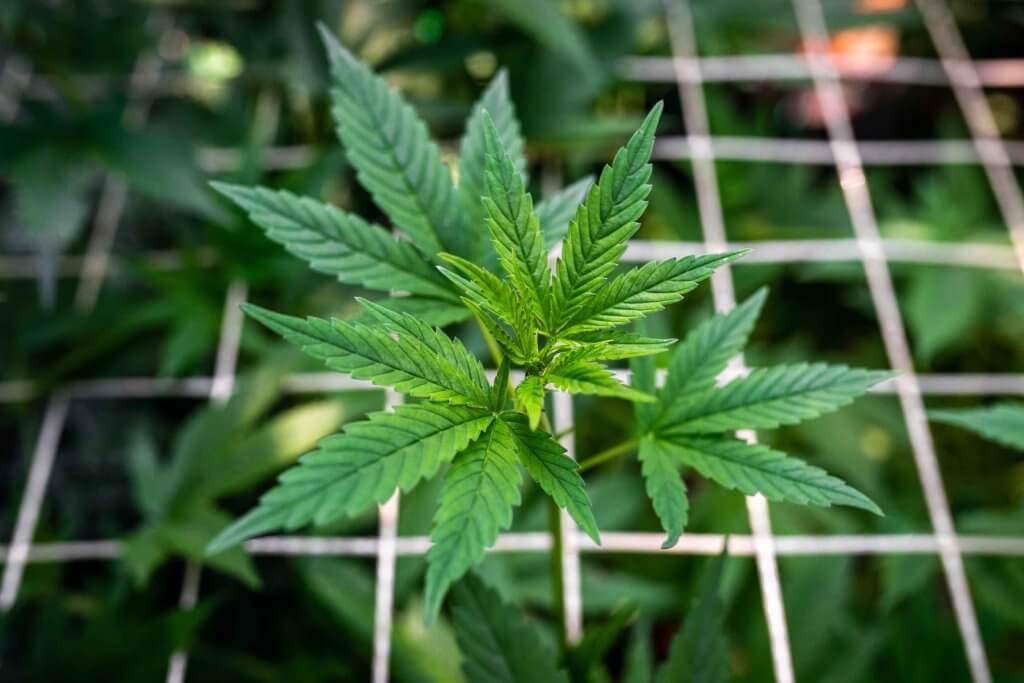
Step 1: DIY Time
The main element of the ScrOG autoflower method is the screen. This supports your plants as they grow, so it must be able to bear some weight and be sturdy. A screen may be made from various materials to suit your budget and setup.
Some growers make a square wooden frame and then run string across it to make the screen. The screen is then installed one of two ways. Either supported from below or suspended from above.
Another simple way to create a screen for LST autoflowers is to use plant trellis netting attached to posts. The posts are placed at the corners of your grow room, with the trellis stretched between them.
Any means of creating a screen is fine as long as it's sturdy and won’t collapse midway through growing.
Step 2: Installation
Once you’ve constructed your screen for LST your autoflowers, it’s time to install it.
Install the screen on supports from below or securely fastened to overhead fixtures. Ideally, you’re low-stress training your autoflowers early. In this case, install the screen a few inches above the current tops of the plants.
As they quickly grow, your crops reach the screen where you’ll attach the branches.
If you’re late starting low-stress training your autoflowers, lower the screen down onto the plants. Get some help to spread out the branches and insert them into appropriately-spaced holes, being careful not to snap or break any limbs.
Once all the branches are evenly spread out and poking through the holes of your screen, secure it in place.
Step 3: The screening process
With the screen in place, it’s time to start low-stress training your autoflowers in earnest. The aim is to expose each branch to the maximum amount of light for productive yields of dense, resinous buds.
Start LST your autoflowers into the screen with the outer branches first. Pull each branch out and away from the central stem to expand its canopy laterally.
Loop the string over and around the branch to fix it in place. This stops the branch from moving back toward the center and supports the huge buds to come.
Keep working around the plant, securing each main branch in place. As you move toward the inner branches, you’ll start to see the results of your work.
Don’t worry too much if some branches aren’t facing the light; they’ll reorient themselves within a matter of hours.
The spread-out canopy achieved by LST your autoflowers with a ScrOG setup allows for maximum light exposure and increased productivity.
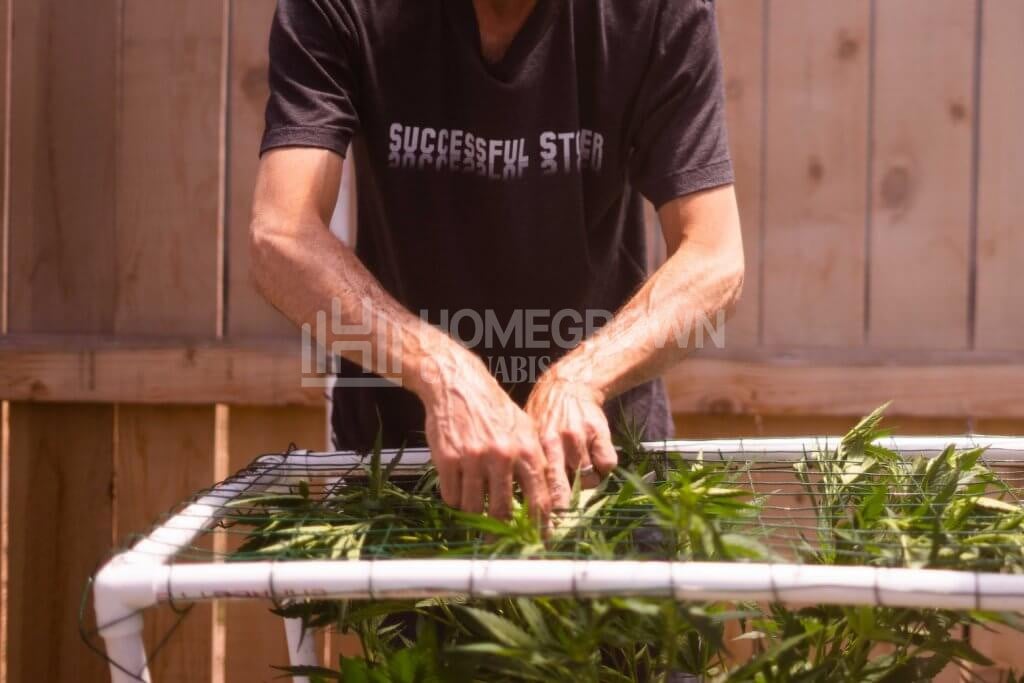
Step 4: Optimizing your screen
While not absolutely necessary, the next step to ScrOG low-stress training your autoflowers is to maximize efficiency.
The idea is to prune away any foliage and growth below the screen. This sends energy up the plant to the light-exposed, trained branches.
Doing this avoids wasted energy on unimpressive lower buds and redirects it into cultivating juicy colas above the screen.
Step 5: Maintaining your screen
The last step in low-stress training autoflowers with a ScrOG is continuous maintenance. Come back and assess your plants every day or two. You’ll likely find stray branches starting to grow past the others, so tie down any new growth to maintain an even canopy.
Continue to LST your autoflowers until the first signs of flowering appear. At this point, you should have a wonderfully flat canopy ready to spring into action and produce copious amounts of bud.
Vertical Screen of Green
A vertical Screen of Green is a more advanced LST autoflower technique. It requires more maintenance and upkeep than the other methods but produces impressive results, especially in larger setups.
Low-stress training autoflowers in a vertical ScrOG follows the same steps as the standard method. The difference is you’re creating a vertical screen of growth instead of a horizontal one.
This LST autoflower method aims to create a wall of growth facing your lights. Growers use this low-stress training autoflower technique with vertically installed lighting for impressive results.
Another variant on the vertical ScrOG creates a cylindrical screen placed around a light. Plants grow through the screen, facing the light to create a tube-like setup with little light loss.
There’s a lot of upkeep required, meaning this is an LST autoflower method best suited to enthusiastic and experienced cultivators.
Low-stress training for autoflowers: Tips to improve your techniques
You’re almost ready to go out there and grow some seriously productive cannabis using low-stress training for autoflowers.
Before you rush off to buy some autoflower seeds, here are some tips to keep in mind when low-stress training autoflowers.
- When bending branches, do so carefully and slowly. The easiest branches to work with are the younger, newer ones. Focus on these primarily, and low-stress training your autoflowers is easy.
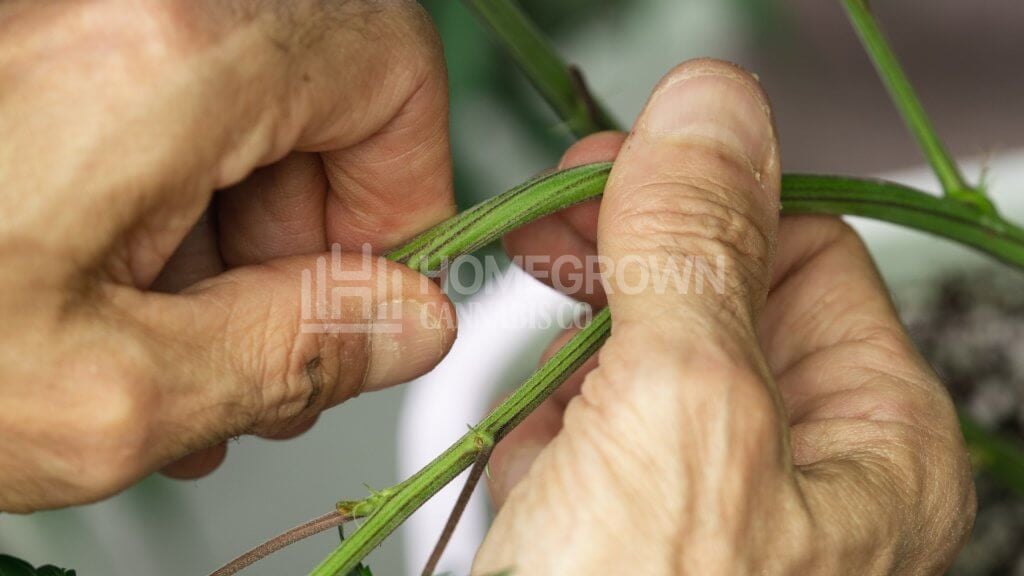
- If you’re low-stress training autoflowers with a ScrOG setup, you may find some branches difficult to get looped into the screen. Use plant ties or clips to attach more stubborn stems to the screen without the need for weaving them through the string.
- If you’ve successfully implemented low-stress training for autoflowers, stretching shouldn’t occur. If you notice a lot of stretching taking place regardless, it’s a sign your plants need more light.
- Always use soft ties and avoid sharp, cutting wires or thin nylon material. These may cut into your plants, causing damage and stunting their growth.
- Regularly check the points of attachment in your LST autoflower setup. Ensure the ties or strings aren’t moving back and forth along the branches. This causes abrasion, removing the protective outer layer of tissue and opening up the plants to potential infection.
Low stress, high success
Low-stress training autoflowers lets growers of all skill levels produce impressively productive crops of cannabis. All these LST autoflower techniques require is a small time investment and some household objects.
In return, you get healthy, flourishing plants that deliver bumper harvests of dense, resinous buds.
Now that you know how to LST your autoflowers, it’s time to grab some autoflower seeds, get them sown, and start growing.
Best of luck with your LST autoflower adventures, we’re sure you’ll do great. Remember to share this with your friends and check out our store for a range of high-quality cannabis seeds.
About the author: Derek LaRose
Also known as Kronic from The Cannabis Kronicles, Derek LaRose is a young ambitious cultivator and a staple educator for indoor cultivation.
